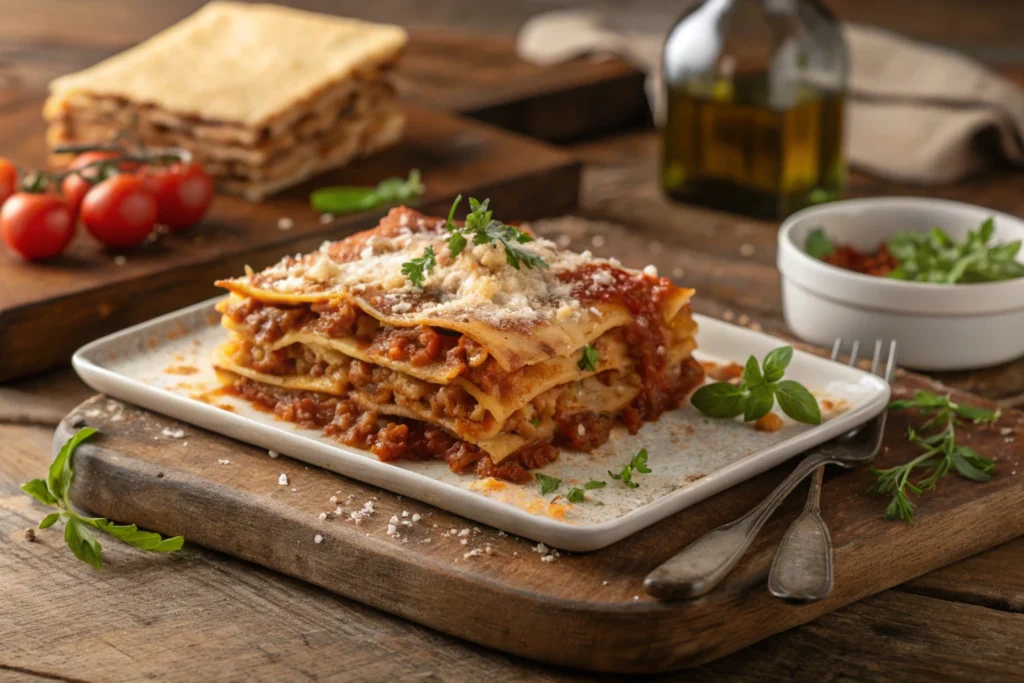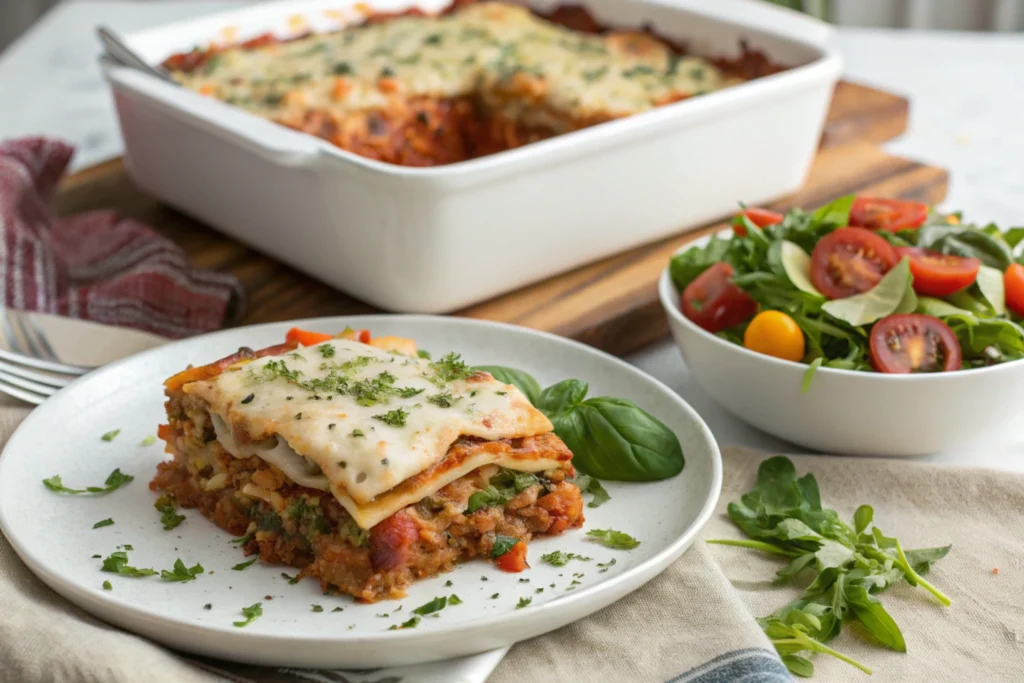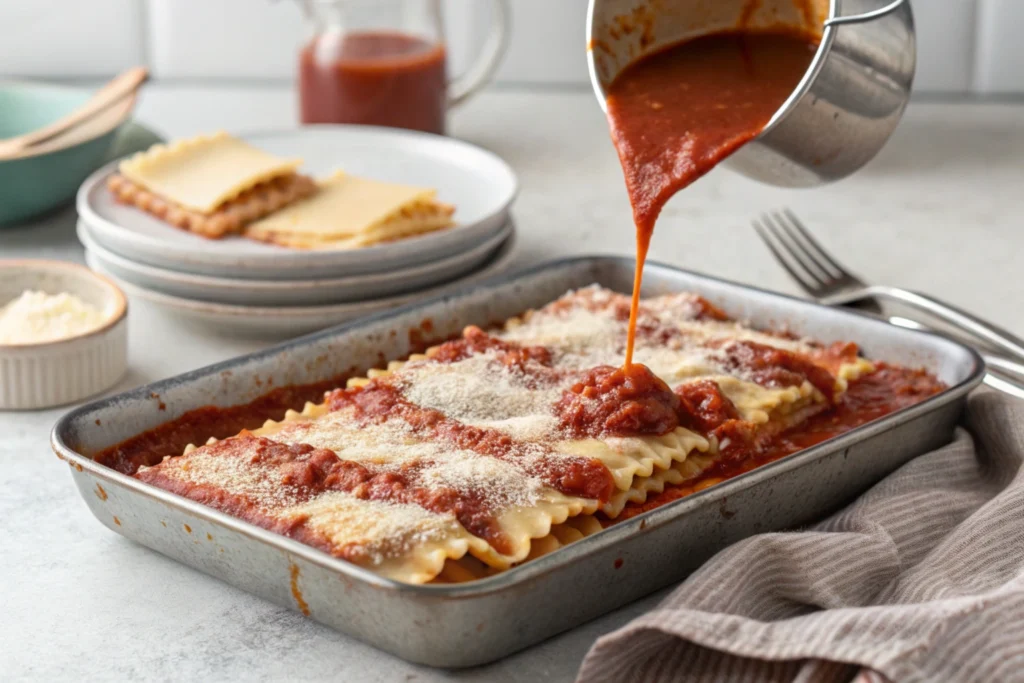
Lasagna has always been a comforting and flavorful dish enjoyed worldwide. However, for individuals with gluten intolerance, celiac disease, or those avoiding gluten, traditional lasagna noodles can pose a problem. Gluten-free lasagna noodles solve this issue by replacing wheat flour with alternative ingredients. They allow everyone to enjoy this classic meal without risking health or dietary preferences.
In this article, we’ll explore everything about gluten-free lasagna noodles. You’ll learn what makes them unique, their ingredients, and the benefits they offer. We’ll also provide tips for making them at home, the best brands to buy, and tasty recipes to try. Whether you’re new to gluten-free cooking or a seasoned pro, this guide will help you create delicious gluten-free lasagna with ease.
Table of Contents
What Are Gluten-Free Lasagna Noodles?
Definition, History, and Key Differences
Gluten-free lasagna noodles are a type of pasta made for people who avoid gluten. Traditional lasagna noodles rely on wheat flour, but gluten-free options use alternative flours like rice, chickpea, or quinoa. These alternatives create noodles that taste and feel similar to regular pasta while remaining safe for gluten-free diets.
The popularity of gluten-free noodles grew significantly in the early 2000s. Increased awareness of celiac disease and gluten sensitivity led to higher demand for these products. Over time, brands improved their recipes, ensuring that gluten-free noodles now offer the same satisfaction as their wheat-based counterparts.
Why Go Gluten-Free?
Many people choose a gluten-free diet for health reasons, while others find it helps them feel better overall. Understanding the benefits of going gluten-free can help you appreciate the value of gluten-free lasagna noodles.
Health Benefits
For individuals with celiac disease or gluten intolerance, avoiding gluten isn’t just a choice—it’s essential. Gluten can cause inflammation, digestive issues, and long-term damage to the intestines for those with sensitivities. Switching to gluten-free options like lasagna noodles eliminates these risks and helps improve digestion, energy levels, and overall well-being.
Even for people without diagnosed conditions, cutting gluten may offer benefits. Some report less bloating, clearer skin, and better focus after reducing gluten intake. Although these effects can vary, gluten-free products provide a versatile alternative for those exploring dietary changes.
Popularity of Gluten-Free Products
The rise of gluten-free products isn’t just a passing trend. According to market research, the demand for gluten-free foods has grown steadily over the last two decades. More people are recognizing the need for inclusivity in dietary options, leading to a boom in gluten-free pasta, bread, and baked goods. Brands now compete to create the tastiest, most reliable gluten-free versions of popular staples like lasagna noodles.
Ingredients in Gluten-Free Lasagna Noodles
One of the key features of gluten-free lasagna noodles lies in their unique ingredients. These noodles swap traditional wheat flour for innovative, naturally gluten-free substitutes. Let’s explore the most popular ones:
Rice Flour Noodles
Rice flour is a common choice for gluten-free lasagna noodles due to its mild flavor and soft texture. These noodles cook quickly and work well in traditional lasagna recipes. The neutral taste of rice flour allows the flavors of the sauce and fillings to shine through, making it a versatile option.
Chickpea Noodles
Chickpea-based noodles offer a hearty, protein-packed alternative. These noodles have a slightly nutty flavor, which pairs well with robust sauces like marinara or Bolognese. They are also higher in fiber, making them a nutritious option for anyone looking to boost their protein intake.
Other Alternatives
Beyond rice and chickpeas, gluten-free lasagna noodles often feature ingredients like corn, quinoa, or cassava. Each of these flours brings its unique properties to the table:
- Corn Flour: Creates noodles with a light, slightly sweet flavor.
- Quinoa Flour: Adds an earthy taste and is rich in protein and nutrients.
- Cassava Flour: Offers a smooth, pliable texture that closely mimics traditional pasta.
These options give gluten-free eaters the flexibility to choose noodles that best suit their preferences.
How to Make Gluten-Free Lasagna Noodles at Home
If you enjoy hands-on cooking, making gluten-free lasagna noodles at home can be a rewarding experience. By preparing your noodles, you can customize the flavor, texture, and ingredients to suit your needs. Plus, it ensures that no hidden gluten sneaks into your meal.
Essential Ingredients
Creating gluten-free lasagna noodles requires only a few basic ingredients. Here’s what you’ll need:
- Gluten-Free Flour: Use rice, chickpea, or a gluten-free all-purpose blend.
- Tapioca Starch or Xanthan Gum: These provide elasticity and hold the noodles together.
- Eggs or Egg Replacer: Acts as a binding agent and adds richness.
- Water or Milk (Optional): Helps achieve the right consistency.
Tools and Equipment
- Rolling Pin or Pasta Maker: For flattening the dough.
- Sharp Knife or Pasta Cutter: To shape the noodles.
- Large Pot: For boiling the noodles.
Step-by-Step Guide
- Mix the Dough: Combine the gluten-free flour with a small amount of starch or xanthan gum. Add eggs and mix until a dough forms. Gradually add water if the mixture feels too dry.
- Knead the Dough: Place the dough on a floured surface and knead for about 5 minutes until it’s smooth and pliable. Gluten-free dough may feel slightly crumbly but should hold together when pressed.
- Roll and Cut: Roll the dough into thin sheets using a rolling pin or pasta maker. Cut the sheets into strips that fit your lasagna pan.
- Pre-Cook the Noodles: Boil the noodles for 2–3 minutes, then transfer them to a bowl of cold water to stop the cooking process.
Pro Tips for Success
- Use a well-floured surface to prevent sticking.
- Roll the dough thinly to ensure even cooking.
- If the dough cracks, knead it with a bit more water until pliable.
Best Store-Bought Gluten-Free Lasagna Noodles
If making noodles from scratch sounds intimidating, plenty of store-bought options can save time without sacrificing quality. Here are some of the best brands for gluten-free lasagna noodles:
Brand Comparisons
- Barilla Gluten-Free Lasagna Noodles: Known for their firm texture and easy preparation, Barilla’s noodles are made with corn and rice flour. They hold up well during cooking and don’t break easily.
- Jovial Gluten-Free Lasagna Sheets: Made from 100% organic brown rice flour, these noodles offer a hearty, earthy flavor and are perfect for traditional lasagna recipes.
- Tinkyada Rice Lasagna Noodles: These noodles are crafted from stone-ground brown rice. They have a delicate taste and maintain their shape, making them ideal for layered dishes.
Where to Buy
You can find gluten-free lasagna noodles in most major grocery stores or online retailers like Amazon, Thrive Market, and Walmart. Some specialty health stores also carry a wide variety of gluten-free pasta options.
Delicious Recipes with Gluten-Free Lasagna Noodles

Cooking with gluten-free lasagna noodles allows you to create a variety of dishes that are both comforting and creative. Here are some popular recipes, including classic and innovative takes, to try in your kitchen.
Classic Gluten-Free Lasagna
This recipe brings traditional Italian flavors to your table using gluten-free noodles. It’s a crowd-pleaser and perfect for family dinners.
Ingredients:
- Gluten-Free Lasagna Noodles (store-bought or homemade)
- Ground Beef or Turkey (1 pound)
- Marinara Sauce (2 cups)
- Ricotta Cheese (1 cup)
- Mozzarella Cheese (2 cups, shredded)
- Parmesan Cheese (1/2 cup, grated)
- Egg (1, lightly beaten)
- Salt and Pepper (to taste)
- Olive Oil (1 tablespoon)
Instructions:
- Prepare the Sauce: Heat olive oil in a skillet, cook the ground meat until browned, and season with salt and pepper. Add marinara sauce and simmer for 10 minutes.
- Mix the Cheese Layer: Combine ricotta, half the mozzarella, Parmesan, and the egg in a bowl. Set aside.
- Assemble the Lasagna: Spread a thin layer of sauce on the bottom of a baking dish. Layer the noodles, cheese mixture, and sauce. Repeat until the dish is filled, finishing with a layer of mozzarella on top.
- Bake: Cover with foil and bake at 375°F (190°C) for 25 minutes. Remove foil and bake for an additional 15 minutes or until bubbly.
Vegan and Dairy-Free Lasagna
For those avoiding dairy or animal products, this vegan lasagna recipe offers rich, satisfying layers without compromise.
Ingredients:
- Gluten-Free Lasagna Noodles
- Vegan Ricotta Cheese (made from cashews or tofu)
- Vegan Mozzarella Cheese (shredded)
- Spinach (2 cups, chopped)
- Tomato Sauce (2 cups)
- Vegetables (zucchini, mushrooms, bell peppers, diced)
Instructions:
- Prepare the Veggies: Sauté zucchini, mushrooms, and peppers in olive oil until tender.
- Layer the Ingredients: Spread tomato sauce at the bottom of a baking dish. Add a layer of noodles, then vegan ricotta, veggies, and sauce. Repeat.
- Bake: Cook at 375°F (190°C) for 30 minutes, uncovered. Let it cool for 10 minutes before serving.
Creative Variations
Mexican Lasagna
Swap marinara for enchilada sauce, use ground chicken or black beans, and add layers of cheddar cheese, jalapeños, and tortillas for a Mexican-inspired twist.
Dessert Lasagna
Try sweet lasagna by layering gluten-free noodles with mascarpone, Nutella, and fresh berries. Top with whipped cream and a dusting of cocoa powder for a decadent dessert.
Common Challenges and Solutions

1. Avoiding Mushy Noodles
Problem: Gluten-free noodles can become overly soft or fall apart during cooking.
Solution: Follow the package instructions closely and avoid overcooking. If pre-boiling noodles, remove them from heat 1–2 minutes before they’re fully cooked. This ensures they don’t become too tender when baked.
2. Handling Breakage
Problem: Gluten-free noodles often lack the elasticity of traditional pasta, making them prone to breaking.
Solution: Work with noodles at room temperature and handle them gently. If a piece breaks, use it in the middle layers of your lasagna where it won’t be noticeable.
3. Layering Consistency
Problem: Gluten-free noodles might cook unevenly, leading to inconsistent textures.
Solution: Make sure the noodles are evenly spaced and submerged in sauce to ensure uniform cooking during baking.
4. Storing Leftovers
Problem: Gluten-free lasagna leftovers can dry out or lose texture in the fridge.
Solution: Store lasagna in an airtight container and reheat with a splash of water or sauce to restore moisture. Avoid freezing cooked gluten-free lasagna, as the noodles can become grainy.
FAQs on Gluten-Free Lasagna Noodles
1. Do gluten-free lasagna noodles taste different?
Not significantly! High-quality gluten-free noodles are designed to closely mimic the taste and texture of traditional pasta. Some variations, like chickpea or quinoa noodles, may have a subtle nutty or earthy flavor.
2. Do I need to precook gluten-free lasagna noodles?
Many brands offer no-boil gluten-free noodles, which can be layered directly into your lasagna. For others, pre-cooking is necessary. Always check the package instructions for guidance.
3. Can I freeze gluten-free lasagna?
Uncooked lasagna with gluten-free noodles freezes well. Assemble the dish, cover tightly, and freeze for up to three months. Thaw in the fridge overnight before baking.
4. What’s the best sauce to use with gluten-free noodles?
Any sauce works, but thicker sauces coat gluten-free noodles better and prevent them from becoming too soft. Marinara, Alfredo, and vegan cheese sauces are great options.
5. Are gluten-free lasagna noodles healthier?
They can be! Gluten-free noodles often have fewer additives and more natural ingredients. Some options, like chickpea or lentil noodles, offer additional protein and fiber compared to wheat-based pasta.
6. Can I make gluten-free lasagna without noodles?
Yes! Thinly sliced vegetables like zucchini, eggplant, or sweet potatoes can replace noodles for a grain-free version of lasagna.
Conclusion
Gluten-free lasagna noodles provide an accessible and delicious way to enjoy this beloved dish without worrying about gluten. Whether you choose store-bought brands or make your own, these noodles offer versatility, flavor, and texture that rival traditional options. From classic lasagna recipes to creative variations, gluten-free noodles let you experiment and enjoy with confidence.
Why wait, then? Get your preferred gluten-free lasagna noodles and begin combining flavors right now. Both your guests and your taste buds will appreciate it!
